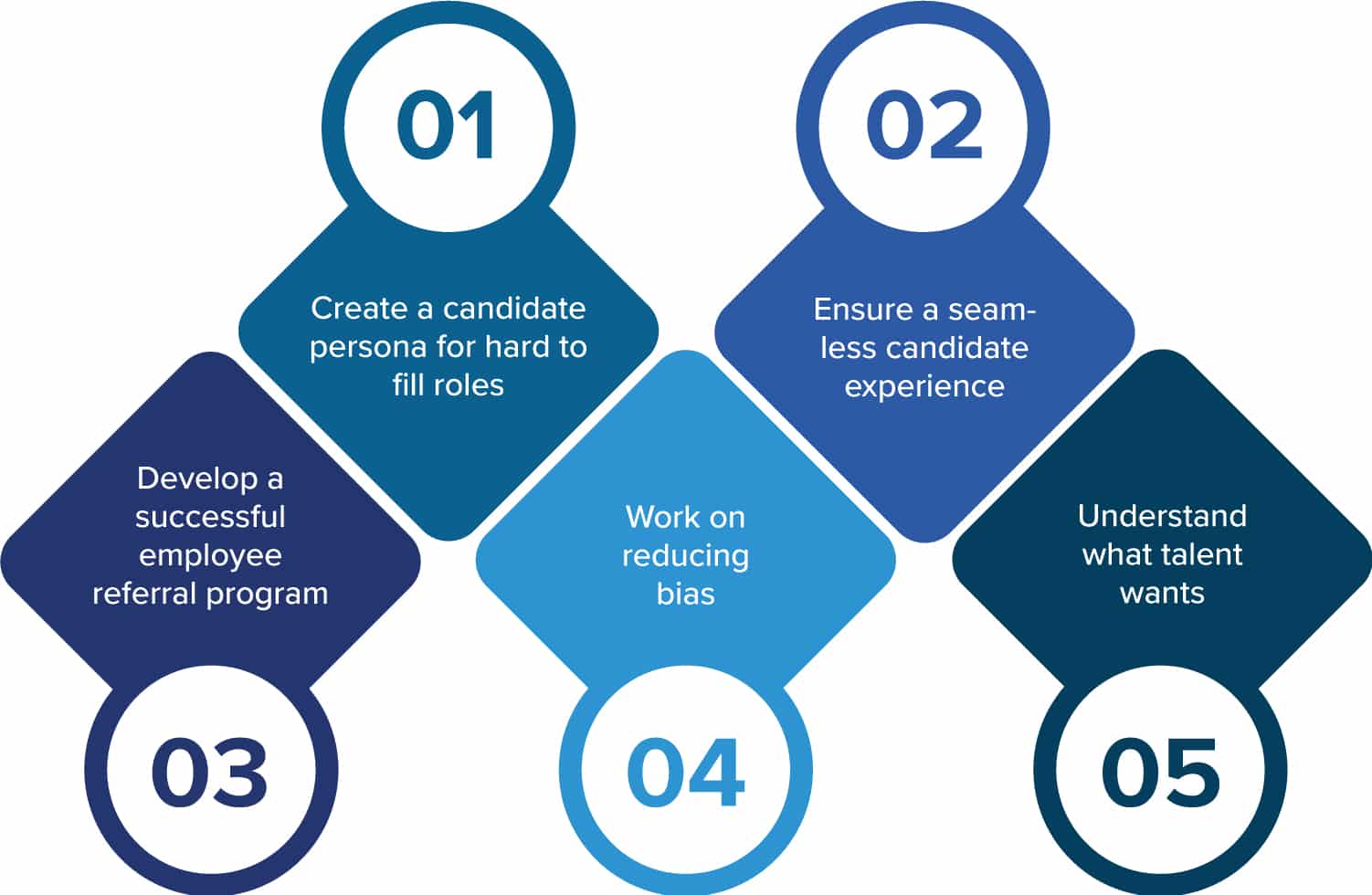In a skills shortage, developing an effective recruitment strategy is critical. Implementing the following five steps will improve your success in talent acquisition and result in a sustainable and effective hiring process.

1. Create a candidate persona for hard to fill roles
The candidate persona can be defined as a template for your ideal hire for a specific role. It brings together your recruitment data on previous hires and informed assumptions about your preferred hire’s experience, motivation, and career aspirations. A candidate persona isn’t required for every vacancy but can be used in every recruitment strategy for:
- Roles that are recruited for in volume or on a frequent basis.
- Highly skilled, hard to fill positions, such as specialist tech roles.
To develop your candidate persona, review the common traits of the most successful hires in a particular role (or across all positions for a new hire), including their career history, why they applied for your jobs and where they entered your recruitment funnel.
Your applicant tracking system should be able to provide you with this information. Follow up with a detailed analysis of their experience, background, work/life balance, likely leisure interests, their personal and professional aims, and what they expect from you as their employer.
Implement these details into your recruitment strategy for each specific role where you use a candidate persona.
2. Ensure a seamless candidate experience
Getting the candidate experience right is essential for effective recruitment strategies. From the first impression of your careers site through to the time it takes to make a job offer, that experience has to be seamless and promote a positive impression of your company. The way in which you handle unsuccessful candidates post-interview also has an impact on how your business is perceived.
Support your entire recruitment process with recruitment software which takes care of the repetitive, routine tasks, enabling you to focus on building the employer-candidate relationship.
3. Develop a successful employee referral program
Research shows that employee referrals provide a better quality of hire. These hires stay longer with your company and are usually a better cultural fit. When developing an effective recruitment strategy aim to make employee referrals your top source of quality hires.
As with a candidate persona, focus on the jobs where talent is harder to source initially and use the tools within your ATS to enable social sharing of your open jobs. Always provide feedback on why a referred candidate didn’t make the grade to your employees and incorporate referral requests in your onboarding process too. An automated hiring process also enables you to fast-track highly qualified and referred applicants.
4. Work on reducing bias
Unconscious bias remains a high-risk factor in making a final candidate selection as gut-feeling is still the number one influence in hiring decisions. Work on reducing the bias in your hiring process to create an effective recruitment strategy by:
- Reviewing your job posts: Choose gender-neutral language in your job posts to attract as diverse a talent pool as possible. Recent research shows that by replacing the word ‘manage’ with ‘develop’ a job post is regarded as more female-friendly. Analyze the male-female applicant ratio in your ATS to evaluate the impact of language in your job posts.
- Analyze your data: In 2017 Vodafone discovered that highly qualified female applicants were applying for its tech vacancies but not being invited for an interview. Again, recruitment analytics will reveal potential bias within your own recruitment strategy.
- Implement evidence-based recruitment: Support all of your hiring decisions with the data gathered in your ATS during the recruitment cycle.
5. Understand what talent wants
An effective recruitment strategy means the pressure is on to get it right first time with every hire. Understanding what talent wants from you can help. Mercer’s 2018 Global Talent Trends study identified three key areas that candidates look for in their next employer.
- Flexible working options: Nearly 9 out of 10 applicants look for flexible working as a preferred option in their job search. At a time when multiple job offers are the norm for highly qualified candidates, flexible working options could transform your potential talent pool.
- Commitment to health & well-being: A greater focus on well-being can attract more talent to your business and promote a more positive employer brand. Gallup found that a positive culture attracts the top 20% of candidates.
- Meaningful work: 2018 is the year of the employee experience and part of that experience is providing your employees with meaningful work. Mercer notes that engaged employees are three times more likely to work for a company with a sense of purpose. Being clear – and consistent – on your culture, values and purpose across your careers site and throughout your hiring process will attract more qualified candidates to your job posts.
Developing effective recruitment strategies requires a consistent approach and should be supported by modern recruitment software to streamline your entire hiring process.




.jpg?width=1000&name=6797cc6580ed37f294dde1be_pexels-linkedin-sales-navigator-7245806%20(1).jpg)


